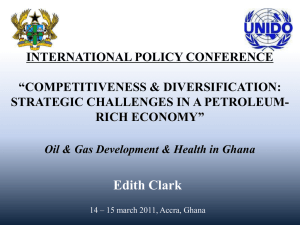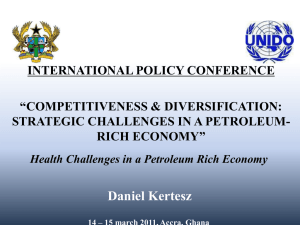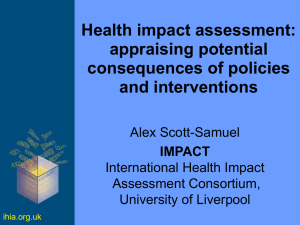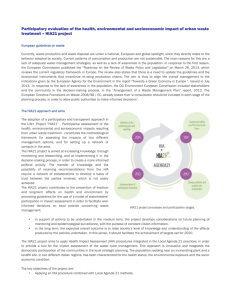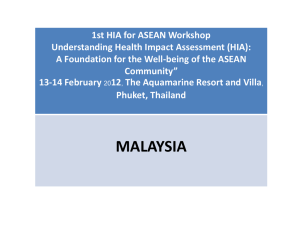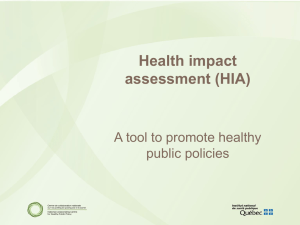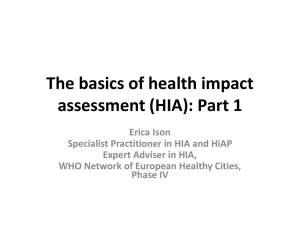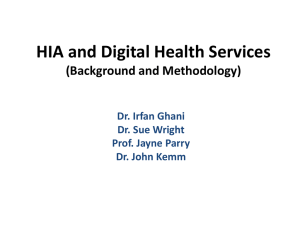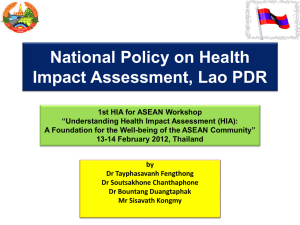Health Impact Assessment, on Auckland Cities Liveable Community
advertisement
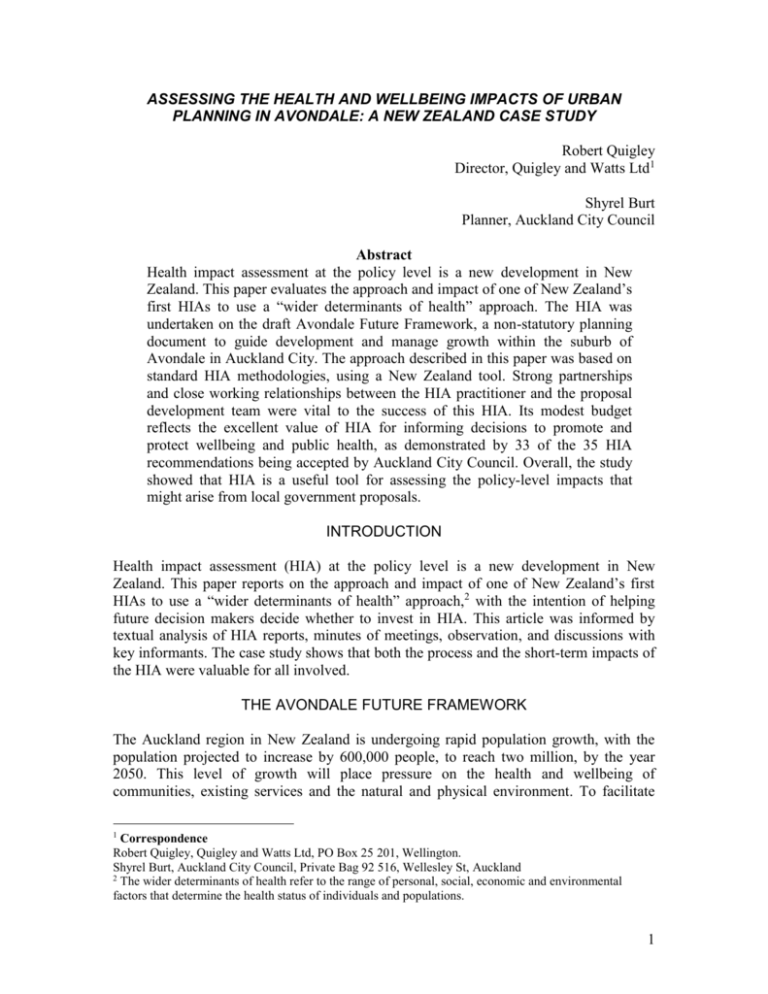
ASSESSING THE HEALTH AND WELLBEING IMPACTS OF URBAN PLANNING IN AVONDALE: A NEW ZEALAND CASE STUDY Robert Quigley Director, Quigley and Watts Ltd1 Shyrel Burt Planner, Auckland City Council Abstract Health impact assessment at the policy level is a new development in New Zealand. This paper evaluates the approach and impact of one of New Zealand’s first HIAs to use a “wider determinants of health” approach. The HIA was undertaken on the draft Avondale Future Framework, a non-statutory planning document to guide development and manage growth within the suburb of Avondale in Auckland City. The approach described in this paper was based on standard HIA methodologies, using a New Zealand tool. Strong partnerships and close working relationships between the HIA practitioner and the proposal development team were vital to the success of this HIA. Its modest budget reflects the excellent value of HIA for informing decisions to promote and protect wellbeing and public health, as demonstrated by 33 of the 35 HIA recommendations being accepted by Auckland City Council. Overall, the study showed that HIA is a useful tool for assessing the policy-level impacts that might arise from local government proposals. INTRODUCTION Health impact assessment (HIA) at the policy level is a new development in New Zealand. This paper reports on the approach and impact of one of New Zealand’s first HIAs to use a “wider determinants of health” approach,2 with the intention of helping future decision makers decide whether to invest in HIA. This article was informed by textual analysis of HIA reports, minutes of meetings, observation, and discussions with key informants. The case study shows that both the process and the short-term impacts of the HIA were valuable for all involved. THE AVONDALE FUTURE FRAMEWORK The Auckland region in New Zealand is undergoing rapid population growth, with the population projected to increase by 600,000 people, to reach two million, by the year 2050. This level of growth will place pressure on the health and wellbeing of communities, existing services and the natural and physical environment. To facilitate 1 Correspondence Robert Quigley, Quigley and Watts Ltd, PO Box 25 201, Wellington. Shyrel Burt, Auckland City Council, Private Bag 92 516, Wellesley St, Auckland 2 The wider determinants of health refer to the range of personal, social, economic and environmental factors that determine the health status of individuals and populations. 1 growth in a sustainable manner the regional and local councils have developed and adopted the Auckland Regional Growth Strategy (Auckland City Council 2003). Under its obligations within this strategy, Auckland City Council has developed future frameworks for 14 growth centres identified in the city. The key themes are to provide for more intensive living environments in town centres that have good access to public transport, open space and employment opportunities. Avondale was identified as a priority one area of change in Auckland City Council’s growth management strategy. (The growth management strategy is the council’s response to the wider Auckland Regional Growth Strategy, which seeks to achieve a compact, urban city.) The draft Avondale’s Future Framework is a non-statutory planning document, which provides a framework to guide development and manage growth within Avondale (Auckland City Council 2005). The development of this framework has been prioritised because Avondale is experiencing growth pressures in its commercial and residential sectors. A draft of the framework (also known as a Liveable Community Plan at the time) was prepared in 2000 (Auckland City Council 2000), and focused on providing capacity for intensification. The Council decided to reappraise the document and to take a community development approach to the development of the framework. This involved going back to the Avondale community (with the objective of listening to the “quiet voices” such as youth, Chinese migrants and Polynesian women) and resulted in a revised version of the framework (Auckland City Council 2005). This was the version that went out for public consultation and that was the focus of the HIA. The key theme of this approach, driven by the Community Development team of Auckland City Council, was openness to new ways of working with the community and developing policy. These included the use of translators with the Chinese community and using artists to undertake consultation. The framework proposed an 800-metre radius from the town centre that set the geographical boundary for intensification, proposing an additional 2,000 households for the 50–60 streets within the zone of intensification. The framework sought to retain the area’s essential character and vitality, while accommodating development. There were five key components: intensification within the Avondale area improving transport and connectivity improvement to the social and community environment improvement to the living environments strengthening the economy. THE AVONDALE HIA PROCESS When work on the draft framework was nearly complete, an approach was made by Auckland Regional Public Health Service to undertake an HIA of an urban development plan within the Auckland City Council. The Auckland City Council project manager in charge of Avondale was open to this concept. No other impact assessments were undertaken on the framework (such as environmental, social or economic impact 2 assessment) and so no overlap or synergies between different methods could be employed. The HIA, commissioned by the Auckland Regional Public Health Service (ARPHS), was undertaken by Quigley and Watts Ltd (Q&W) with the full support of the Auckland City Council. A steering group consisting of ARPHS and Auckland City Council representatives provided direction and insight for the HIA process. The two authors of this article were involved in different aspects of the HIA: Robert Quigley led the HIA and Shyrel Burt was involved in the development of the framework and the implementation of the HIA’s recommendations. The HIA followed the stages of the Public Health Advisory Committee (2005) guide on HIAs: screening scoping appraisal and reporting monitoring and evaluation. Deciding Whether to Do an HIA (Screening) Auckland City Council asked ARPHS and Q&W for initial comments on the draft framework, which was just about to go to the council for sign-off prior to a further round of public consultation. Since there were only three working days to present their comments, Q&W and ARPHS decided to carry out a “screening” step on the framework. The purpose of this was to confirm that an appropriate proposal for an HIA had been chosen, to provide a chance to develop capacity and understanding of the HIA approach at ARPHS in a real-life setting, and to see if any initial thoughts on potential changes to the plan might come to light while undertaking the screening. The screening was based directly on the nine screening questions in the Public Health Advisory Committee guide (2005), covering potential positive and negative impacts and their severity, equity and community issues, and political support for doing the HIA. The screening report (which was submitted to Auckland City Council) outlined the key features of the policy, the likely populations affected, the determinants of health that might be affected, the possible mitigations/enhancements that surfaced and some of the community concerns about health and wellbeing impacts. The framework was found to be very suitable for an HIA due to the breadth of determinants of health affected, the number of people affected, the magnitude of potential health impacts, the level of community concern about wellbeing impacts and the potential to affect vulnerable groups. The screening report provided an opportunity to raise the profile of public health within Auckland City Council at an early stage in the HIA, and showed that the HIA approach was responsive to the council planners’ needs, in that something practical could be achieved with just three days’ notice. The report highlighted the likely direction of potential health impacts, but due to the time frames for going to the council, only a small 3 number of changes were made to this draft of the framework. However, this effort to help Auckland City Council wherever possible set the scene for developing strong relationships between the agencies and individuals participating; the importance of this cannot be overestimated. Scoping – Setting the Boundaries of the HIA A steering group was set up to determine the boundaries for the HIA. Membership of the group was decided on jointly by Auckland City Council, ARPHS and Q&W, who succeeded in getting representation from the community, public health and city council. The group comprised representatives from Auckland City Council (five members), ARPHS (three) and Avondale Community Board (two). Prior to the meeting, a letter was sent to the participants outlining the general purpose of the HIA (to assess the potential health and wellbeing impacts of the framework) and the specific purpose of the meeting (to ensure the HIA met stakeholders’ needs). The letter also included the agenda, a list of questions that needed to be answered at the meeting (Ison 2002), and the latest version of the framework. The half-day scoping meeting allowed the participants to set the direction of the HIA, ensuring it answered questions of importance to the community, the council and to public health. The meeting provided direction on: the elements of the framework to be assessed population groups of most interest geographical area determinants of health and wellbeing affected by the framework. Since this was one of the first HIAs in New Zealand to use a “wider determinants of health” approach, it was agreed that the HIA should focus on the action points of the plan, because they were more tangible for assessing impacts. The entire population of Avondale was going to be affected by the framework, and the most vulnerable groups in the population provided the focus for the HIA. The geographical area of study for the HIA extended beyond the 800-metre radius of the town centre to include the local wards, because the effects of the framework would also extend beyond this zone of intensification. Having many Auckland City Council staff and ARPHS staff present ensured that the profile of public health was raised in the Council, and having the authors of the framework present allowed them to set the direction of the assessment into areas that most needed attention. This also demonstrated to the Council staff how closely their wellbeing concerns matched those of the community and public health workers, providing a strong base for carrying out the assessment within the chosen boundaries. The methodology used for the HIA was discussed and agreed; it included a rapid review of national and international public health evidence for the determinants of health potentially affected, an analysis of the consultation undertaken by Auckland City Council 4 on Avondale’s Future Framework, a review of existing plans and strategies, and a daylong appraisal workshop. The meeting also set the aims for the HIA, which were to: identify the positive and negative health and wellbeing impacts of Avondale’s Future Framework inform the writing of the plan to enhance connected communities, make transparent any trade-offs, and provide recommendations that enhanced positive impacts and mitigated negative impacts provide information on the positive impacts that could be used to support the progress of the plan strengthen partnerships between public services providers, funders and other interested groups (Quigley and Watts 2005). Carrying Out the Appraisal A day-long appraisal workshop was hosted by Auckland City Council with the purpose of gathering stakeholder views on how the draft Avondale’s Future Framework might affect the health and wellbeing of the local population, and how it could be revised to improve health and wellbeing or reduce any harmful impacts on health and wellbeing. Those participants who were considered important to have at the workshop had been identified at the initial scoping meeting, and they represented a wide range of organisations and disciplines. People on this list were also able to add additional organisations and names once they realised the purpose of the workshop. The attendees included representatives from: Auckland Regional Public Health Service Auckland City Council Ministry of Education Auckland University Auckland Regional Transport Authority Work and Income NZ alternative education (Mount Albert Grammar School) Police Housing New Zealand Corporation Auckland City Council’s community development workers. The HIA provided the opportunity to bring key stakeholders together to review the draft framework within the context of health and wellbeing. The inclusion of professionals in their respective fields (e.g. health, police, education) from both inside and outside the community meant that the comments heard by the Auckland City Council during the workshop helped to avoid a NIMBY (not in my back yard) reaction, which council officials believed had made up a significant proportion of previous comments received on Auckland City Council frameworks. Presentations to the workshop included a description of the framework, evidence about the link between particular interventions and health impacts, a summary of previous community consultation, a summary of existing plans and strategies, and a profile of the 5 community. Data were sought from a variety of agencies, but not all were able to provide it within the timeframes required. At the workshop, small groups selected components of the framework to work on and chose the actions within each component to assess. This structure allowed for each part of the framework to be considered at least once by at least one of the groups. The groups answered a set of structured questions adapted from a United Kingdom rapid appraisal tool (Ison 2002), rather than the more in-depth Public Health Advisory Committee health appraisal tool. The questions, set out in a matrix, covered: the determinant of health affected by the action point’s implementation (with particular reference placed on determinants of interest in this HIA) a description of the direct or indirect health impact predicted a description of key factors that may encourage or prevent the health impact a judgment on the positive or negative nature of the health impact a listing of the populations potentially affected (with particular reference to populations of interest in this HIA) a listing of populations that may be differentially affected (with particular reference to populations of interest in this HIA). The results from the workshop questions were subsequently re-worked through the Public Health Advisory Committee (2005) policy-level HIA tool (by Q&W) to further test, integrate and explore potential wellbeing impacts. Both positive and negative potential health and wellbeing impacts of the framework were identified, although the majority were positive. This was probably due to the community development approach taken to develop the most recent version of the framework, and the framework’s broad focus on five inter-related key strategies. The impacts on wellbeing and the determinants of health that were identified in one part of the framework were often replicated in other parts due to the inter-connected nature of the framework. This was beneficial, because proposing solutions to enhance or mitigate wellbeing impacts for one issue often enhanced or mitigated other actions in the framework. A number of recommendations were put forward at the workshop and through subsequent discussions with stakeholders. However, those taken through into the final report recommendations were required to have supporting evidence and offer practical mitigations or enhancements. They also needed to meet at least one of the following criteria: match residents’ concerns affect a large number of people cause a significant impact disproportionately affect a vulnerable group. This helped ensure that any recommendations put to Auckland City Council were robust, practical, evidence-based and desirable for the community and stakeholders. A final 6 report carrying the HIA recommendations to amend actions in the framework was considered by Auckland City Council to be “constructive, carefully worded and easily incorporated into the document” (personal communication, Shyrel Burt, Auckland City Council planner, 2006). The recommendations addressed key areas, including: making buildings more accessible assessing new developments for impacts on health and wellbeing, safety, crime prevention and impacts on people with disabilities incorporating safe places for children to play strengthening pedestrian and cycle initiatives a focus on children and young people, including child safety and open space catering for youth. Some of the HIA recommendations covered areas that Auckland City Council already addressed as “business as usual” within existing policies, and in these cases the HIA served to reinforce these policies and their approach. Evaluation of the Appraisal Workshop The 18 people who attended the workshop received evaluation forms and 15 responded. The results indicated that the workshop was highly valued, provided significantly increased understanding of health and its determinants, and was a very good opportunity for developing cross-sector linkages and collaboration. All respondents said they would participate in another HIA rapid appraisal workshop given the chance. Participants made the following comments: “A strength was the good open communication with opportunities for everyone to have input.” “Networking, experiences and backgrounds of people, sharing information, bringing minds together and knowing that you are part of something that could have a positive impact on the community were all features of the workshop.” “The openness and willingness of participants to contribute and take the time to attend was great – probably due to Council’s willingness to listen as well.” Resources Used The HIA was funded by ARPHS for $20,000. Additional costs were incurred catering the scoping and stakeholder meetings ($600) and transporting participants ($2,700). We also calculated the value of the time put into the HIA by ARPHS and council staff and other participants, mainly at the screening, scoping and appraisal meetings, and also including time between the meetings for emails, phone calls, meetings and document reviewing. Valued at $35 per hour (plus overheads of 50%), the 250 hours of time amounted to $13,125. This brought the total cost of the HIA to NZ $36,425. 7 IMPACT ON DECISION MAKING AND IMPLEMENTATION OF THE FRAMEWORK The HIA was reported to city councillors sitting on a panel charged with hearing all of the public comments to the draft framework. The panel therefore heard the HIA as part of a wider package of comments. The HIA brought a fresh approach to the analysis of comments (personal communication, S. Burt, Auckland City Council planner, 2006). Introducing HIA recommendations this way was good for tying the HIA recommendations into the broader consultation and usual Auckland City Council processes, but it had disadvantages for the general promotion of HIAs. The process did not provide a good platform for the presentation of the HIA approach as a policy assessment tool to the panel – this was lost in their consideration of the recommendations. As a result, this has hampered the uptake of HIA by decision makers. Instead, Auckland City Council staff believed a separate report on the HIA approach, as a tool to assist the framework development process, should have also been presented to the panel, along with the recommendations. Time constraints and a change of Auckland City Council project manager limited the extent to which the recommendations could be incorporated into the draft framework. However, over the course of several months and after internal discussions with councillors and staff, 33 of the 35 recommendations put forward in the HIA (some of which were unique to the HIA) were signed off by the Auckland City Council. After adoption of the framework document, the next stage in the policy process was the development of implementation plans and project briefs for each of the actions, and this is where the HIA has significant potential to influence further action, by providing an opportunity to incorporate the HIA recommendations into the council processes. This has been facilitated by the policymaker in charge of the project plan development (the project plan is the implementation stage of the framework). ARPHS was very pleased by the positive public health influence arising from the HIA approach, especially in comparison to the usual methods employed by ARPHS to inform external agencies. A policy coordinator from ARPHS noted: “As an organisation, we have been looking at meaningful ways to engage with local authorities on addressing common health and wellbeing issues. The use of policylevel HIA provided us with the formal framework that we needed to explore those links. It exceeded our expectations of what the process could achieve.” (personal communication, M. Soeberg, 2005) Similar comments were reported for Auckland City Council: the HIA project helped to build the Council’s relationship with ARPHS and provided ARPHS with an “in” to the Council’s growth projects. Council officers were pleased with the ability of the HIA to support their work, not only showing where improvements could be made, but providing positive support for the 8 already existing work that promoted and protected wellbeing and public health, thereby helping to ensure such work remained in the framework and was not removed during development. It also provided a deeper look at some issues that were otherwise not covered in other methods of consultation. The planner in charge of implementing the HIA (Shyrel Burt) expressed the following view following the process: “HIA is a useful policy development tool, it is a robust tool for rigorously evaluating policy from a wide range of perspectives using a health lens. It also provided another opportunity to engage stakeholders and involved them in the development of the Framework in a tangible manner.” (personal communication, Auckland City Council planner, 2005) Taking an HIA approach to policy development brings health issues to the fore. The wellbeing benefits of many policy initiatives often get lost in the wider messages of a project. For example, the benefits of walking to school often focus on traffic reduction and alleviating the chaos at the school gate. The physical and mental health benefits of walking to school tend not to receive as much publicity. Although the HIA was specific to Avondale, the findings and recommendations were considered by Auckland City Council staff to have relevance to other growth projects in the city. Following the HIA, a joint Auckland City Council and ARPHS HIA training course was requested and run with over 30 participants, signifying how the Council valued the HIA process that had just occurred. Also, since the HIA training, Council staff have advocated for the use of HIA to central government agencies who are delivering large infrastructure projects within Auckland. Finally, the HIA method was excellent for bringing a diverse group of stakeholders together to comment on the framework. The HIA acted as the cement to bring together organisations with diverse goals and objectives. This was commented on by all involved, and is best summed up by a comment from one of the workshop participants: “It’s an inter-sectoral approach, with lots of expertise and skills in the room. It addresses wellbeing in a broad and holistic way”. FUTURE USE OF HIA BY THE AUCKLAND CITY COUNCIL Further opportunities to use HIA in a formal manner have not arisen at Auckland City Council since the training was completed, but staff who attended the HIA training have used HIA to informally evaluate projects and staff awareness of wellbeing and public health has been raised significantly. For example, public health methodologies are now being developed and piloted by the Community Development team to promote community wellbeing and this was a direct result of the Avondale HIA where leaders in the Auckland City Council recognised the value of public health methods. To further raise the profile of HIA as a policy assessment tool at Auckland City Council, HIA needs to be used again, and comprehensively reported on. Discussions continue between the different parties about potential HIA projects. 9 CONCLUSION By using a collaborative process and social determinants of health approach, this HIA was able to contribute significantly to cross-sector working and placing wellbeing and public health on the agenda. The HIA followed the typical stages of an HIA, providing structure and rigour to the exercise. All workshop participants, including those from outside the health sector, wanted to participate in future HIAs. Strong partnerships and close working relationships between the HIA practitioner and the proposal development team were vital to the success of this HIA. Its modest budget reflects the excellent value of HIA for informing decisions to promote and protect wellbeing and public health, as demonstrated by 33 of the 35 HIA recommendations being accepted by the Council. HIA is a useful tool for assessing the policy-level impacts that might arise from local government proposals. REFERENCES Auckland City Council (2000) Avondale Liveable Community Plan, Draft One (unpublished), Auckland City Council, Auckland. Auckland City Council (2003) Auckland City: Growth Management Strategy, Auckland City Council, Auckland. Auckland City Council (2005) Avondale’s Future Framework, Auckland City Council, Auckland. Ison, E. (2002) Rapid Appraisal Tool for Health Impact Assessment: A Task Based Approach, 11th iteration, Faculty of Public Health Medicine, Oxford. Public Health Advisory Committee (2005) A Guide to Health Impact Assessment: A Policy Tool for New Zealand, Public Health Advisory Committee, Wellington. Quigley and Watts Ltd (2005) Avondale’s Future Framework Rapid HIA: Final Report, Quigley and Watts Ltd, Wellington. 10
